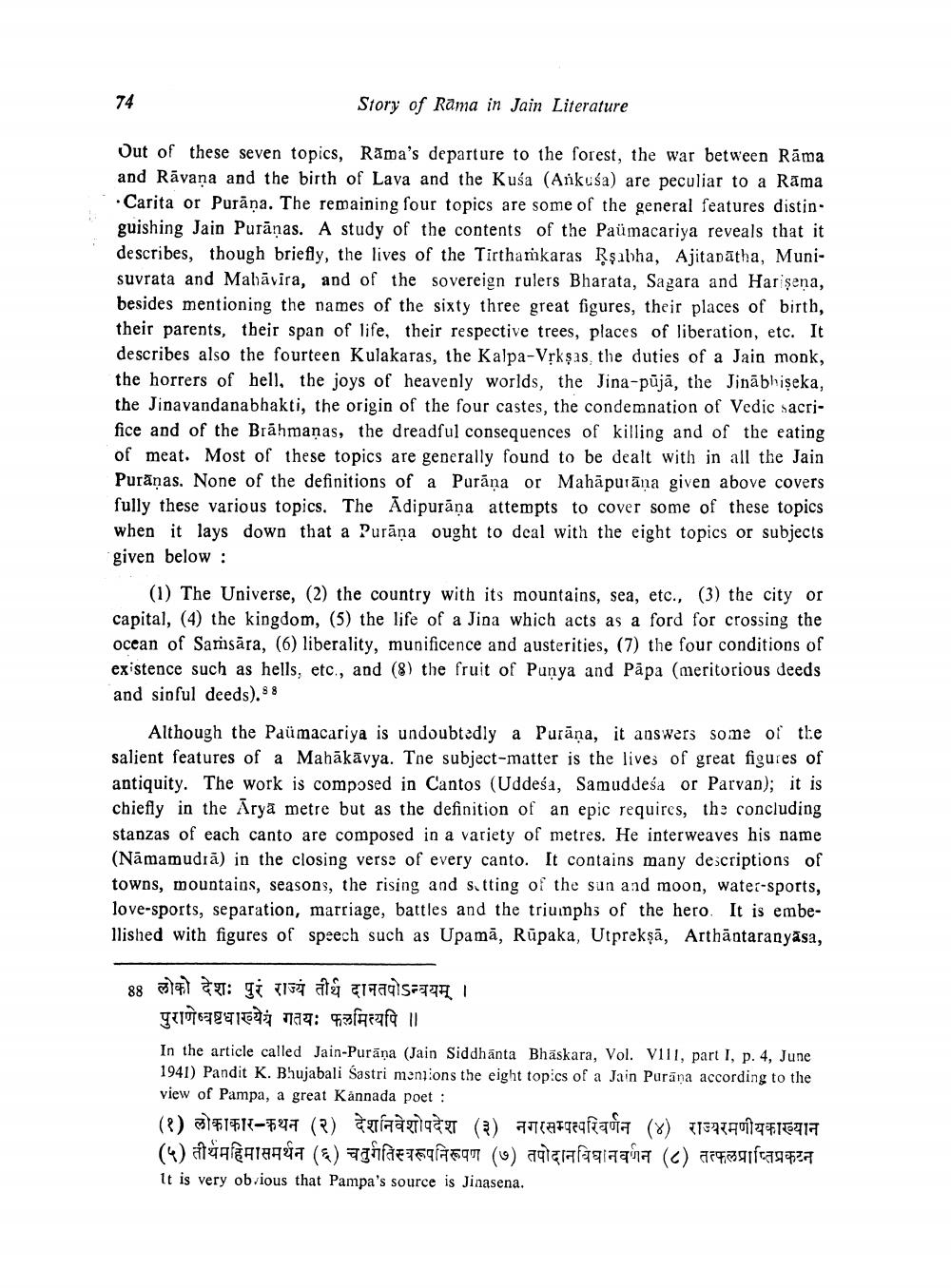________________
Story of Rama in Jain Literature
Out of these seven topics, Rama's departure to the forest, the war between Rāma and Ravana and the birth of Lava and the Kusa (Ankusa) are peculiar to a Rama Carita or Purana. The remaining four topics are some of the general features distin guishing Jain Puranas. A study of the contents of the Palmacariya reveals that it describes, though briefly, the lives of the Tirthamkaras sabha, Ajitanatha, Munisuvrata and Mahavira, and of the sovereign rulers Bharata, Sagara and Harisena, besides mentioning the names of the sixty three great figures, their places of birth, their parents, their span of life. their respective trees, places of liberation, etc. It describes also the fourteen Kulakaras, the Kalpa-Vrksas, the duties of a Jain monk, the horrers of hell, the joys of heavenly worlds, the Jina-puja, the Jinabhiseka, the Jinavandanabhakti, the origin of the four castes, the condemnation of Vedic sacrifice and of the Brahmanas, the dreadful consequences of killing and of the eating of meat. Most of these topics are generally found to be dealt with in all the Jain Puranas. None of the definitions of a Purana or Mahapuräna given above covers fully these various topics. The Adipurana attempts to cover some of these topics when it lays down that a Purana ought to deal with the eight topics or subjects. given below:
74
(1) The Universe, (2) the country with its mountains, sea, etc., (3) the city or capital, (4) the kingdom, (5) the life of a Jina which acts as a ford for crossing the ocean of Samsara, (6) liberality, munificence and austerities, (7) the four conditions of existence such as hells, etc., and (8) the fruit of Punya and Papa (meritorious deeds and sinful deeds),
Although the Paumacariya is undoubtedly a Purana, it answers some of the salient features of a Mahakavya. The subject-matter is the lives of great figures of antiquity. The work is composed in Cantos (Uddeśa, Samuddeśa or Parvan); it is chiefly in the Arya metre but as the definition of an epic requires, the concluding stanzas of each canto are composed in a variety of metres. He interweaves his name (Namamudra) in the closing verse of every canto. It contains many descriptions of towns, mountains, seasons, the rising and s. tting of the sun and moon, water-sports, love-sports, separation, marriage, battles and the triumphs of the hero. It is embellished with figures of speech such as Upama, Rūpaka, Utprekṣā, Arthäntaranyasa,
88 लोको देशः पुरं राज्यं तीर्थ दामतपोऽन्ययम् ।
पुराणेष्वष्टधाख्येये गतयः फलमित्यपि ॥
In the article called Jain-Purana (Jain Siddhanta Bhaskara, Vol. V111, part I, p. 4, June 1941) Pandit K. Bhujabali Sastri mentions the eight topics of a Jain Purana according to the view of Pampa, a great Kannada poet :
(१) लोकाकार - कथन ( २ ) देशनिवेशोपदेश (३) नगरसम्पत्परिवर्णन (४) राज्यरमणीयकाख्यान (५) तीर्थमहिमा समर्थन (६) चतुर्गतिस्वरूपनिरूपण (७) तपोदानविधानवर्णन (८) तत्फलप्राप्तिप्रकटन
It is very obvious that Pampa's source is Jinasena.




